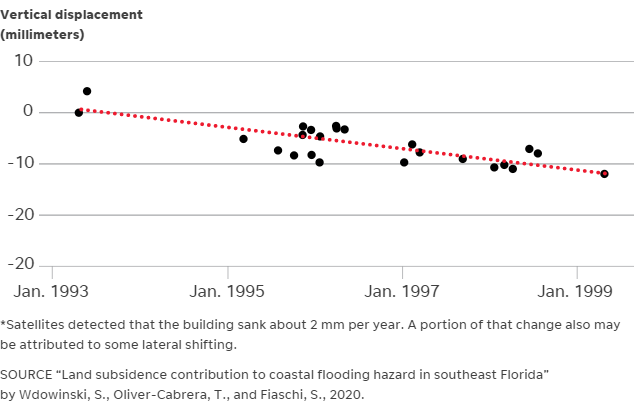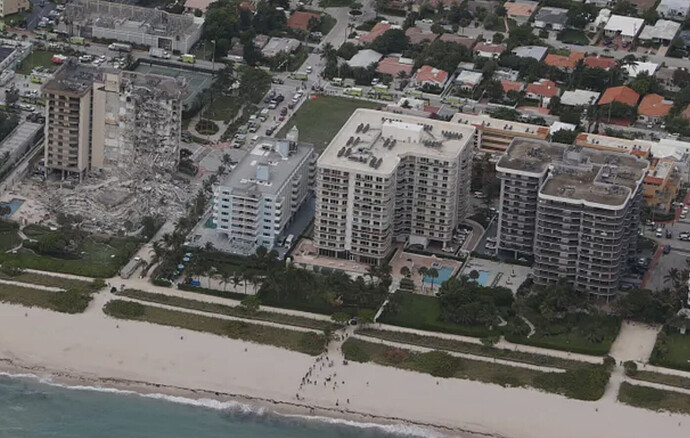Yeah, it really seems like this is going to be a major event, both in terms of the scale of disaster and the implications it could have in Florida.
Seconded. I would like to be able to keep track of developments in a single thread.
Legit lol
These other buildings to the right look like the same design. I can’t imagine those residents are going to sleep comfortably.
Does this kind of collapse ever happen unless we’re looking at a major earthquake, demolition, aerial bombing, 9/11, or 3rd world no-building-code buildings? I don’t remember a similar event happening in the US.
From what I can see this looks like a pretty standard reinforced concrete residential building. I don’t know anything about how building codes in FL differ from the rest of the country or how building codes in 1980 differ from today. We also can’t rule out the possibility that the building never met the code that applied at the time of its construction.
This is one of the most significant catastrophic structural failures in U.S. history, so they will eventually get to the bottom of the cause. It may not have as high of a death tally as the Kansas City Hyatt Regency disaster (although it looks like it will be close), but from a structural standpoint it seems way more significant.
I saw ZZ post an article about the building sinking into the sand at an unusually fast rate. The article is paywalled, so not sure if there are any other details.
Looking at the video of the collapse, the point of failure seems to be roughly in the middle of the building. After the middle collapses, one wing of the building is still standing briefly but falls down partly because it’s getting pulled down by the middle and partly because it likely can’t support its own weight without the columns from the middle.
If you’re interested in this type of stuff, I would recommend the book Why Buildings Fall Down.
NOLA had a hotel collapse that was awful. It was still in construction IIRC so it was empty which is good. There was three people who died and one body was left in there for months because it was too unsafe to go in. Closest I can think of, and obviously this is much worse.
Structural building codes for commercial projects don’t really work the same way as residential ones. The scale and number of variables make it prohibitive to write prescriptive code that can accommodate projects that large and varied. The structural details for commercial projects are developed by structural engineering firms that are licensed to practice in the relevant jurisdiction. There are some base requirements, particularly seismic ones in prone regions, but for the most part if somebody with an engineer’s stamp says it’s good to go, it’s good to go. There’s nobody in a regulatory position who can say otherwise.
It can according to some guy that wrote a book called “Why Buildings fall down” or something like that. He was quoted in an article that someone posted about how the building was sinking.
I think it was a Hard Rock, right?
Yeah that’s right all the sites I worked on dealt with engineers and never city inspectors.
Any chance it has something to do with sea level rise?
I know someone who lives in the Millennium Tower - they said it’s really bad - balls go careening across the floor under their own power.
via NYT
The partially collapsed building near Miami was about to undergo extensive repairs for rusted steel and damaged concrete, said a lawyer who represented the residents association. Nothing suggests the collapse is related to that work, he added.
Lol @ not related.
Sure, sometimes we find out the builder was a crook and used like cheap steel or concrete or something that wasn’t up to code to save money.
zikzak posted it and I just read it. I’m not really in a position to question this but

Man, those are some impressive satellites. They measured a vertical displacement of 12 mm (a little less than half an inch!) over a 6 year period. In one place the story says
A 1990s study of land displacement in the area of the Champlain Towers South complex shows the land sank roughly 2 millimeters a year over the course of the study.
That’s different from the note below the graph, which says the building sank. I also note there are no error bars.
I don’t know that if someone showed me this data for the building I live in that I’d be all that alarmed.

For comparison with the collapsed building, this SF tower is a 58 story structure where
As of 2018, the sinking has increased to 18 inches with a lean of 14 inches.[34]
I wonder how much difference earthquake construction requirements help the building? Seems like it would have a significant advantage in a situation where the foundation is sinking but I’m not at all qualified to evaluate that.
